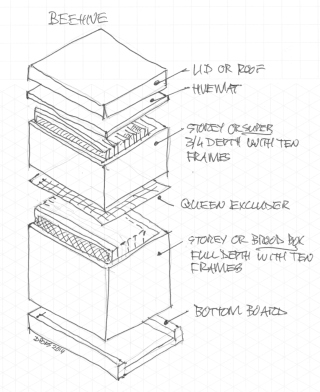Bee Barn
At the desk, 7:55 a.m.
One of the hardest things to understand about beekeeping, even for everyone who does it, is the tremendous amount of stuff that goes with it.
What kind of stuff? Think of it this way:

A typical single hive has:
1 bottom board and/or a screen bottom board
2 hive bodies each with 8-10 'frames' inside them
1-3 honey supers with 8-10 short frames inside them
1 telescoping cover
1 top cover
That's not to mention foundation (the stuff that goes in the frames), tools to work the hives, any food you might feed them, supplies to collect honey, jars, etc. One hive has a lot of stuff. If you have more than one hive, it's that much more.
And, if you run out of woodware (the boxes and frames are made out of wood) in the middle of the summer, you can easily be stuck because the suppliers are out of whatever you need. The best policy is to have everything you think you might need and then some.
There's just a lot of stuff that goes with beekeeping.
We used to keep it all on our milk porch. With the advent of the Bayer pesticide induced CCD, we've have had cycles of beekeeping. Some summers, we have a number of healthy hives and need a lot of equipment. More times than not, the bees don't survive the winter. We'd have a room full of equipment for the winter and mostly empty for the summer. To remedy this and get some space back on our milk porch, we built a small shed on the alley. We call the shed our "Bee Barn."
I spent the morning in the bee barn trying to clean up from last summer. Last year, we fought three bee deadly obstacles - the pesticides our neighbors use, torrential rain in July, and this:
Suffice it to say, we stuffed everything in the shed, slammed the door closed, and ran away.
Since we're expecting to get at least one hive this month, now is the time to clean up and get ready.
The problem is that if I go out in the day light, the bee barn gets surrounded by hungry bees. Bees can be the ultimate scavengers and they will take all the wax and any honey in the bee barn. The only way to get in the shed and get it cleaned out is to go out when it's cold and/or dark.
This morning, around 5:30 a.m. I went out and worked in the bee barn. I was able to clear out some frame that were overrun by the disgusting wax moth. (Our winter was too mild and some of the boxes didn't freeze which is our usual method of controlling wax moth.) I made some progress, and realized I also need to find some different solutions.
I maybe be in the bee barn almost every morning this week. Whatever it takes to get it tidy enough so that when we have bees, we can just rock.
I guess I'm excited.
-----
